


Intercultural Communication professor grateful to help shape China’s burgeoning IC discipline
As a young boy growing up in the U.S., Steve J. Kulich first became aware of China after seeing Chinese characters on the wrapping paper of fireworks. In college it was his Chinese classmates who fostered his interest in seeking a teaching job on this side of the world. After working for a number of years among Chinese, he met his German wife, and their shared interests led the newlyweds to study Chinese at tranquil Xiamen University. Later, the young family moved to Shanghai with their two daughters, where they have now lived for 25 years. Multicultural at home and embracing cultures in his work life, he has actively engaged in intercultural communication to bridge the increasingly dwindling gap between China and the world.
As a scholar, Steve is now Executive Director of Shanghai International Studies University’s (SISU) Intercultural Institute (SII) and engages in research on intercultural values and identity. In a modest library room at SISU, we met Steve – the same room where the first segments of the SISU-FutureLearn “Intercultural Communication” MOOC course were filmed, taught twice a year and to date enrolling 45,000 online learners around the world. Through him and the SISU Educator team, Chinese students meet the world and the world gets to know more about intercultural aspects of Chinese cultural identities, values, and communication styles.
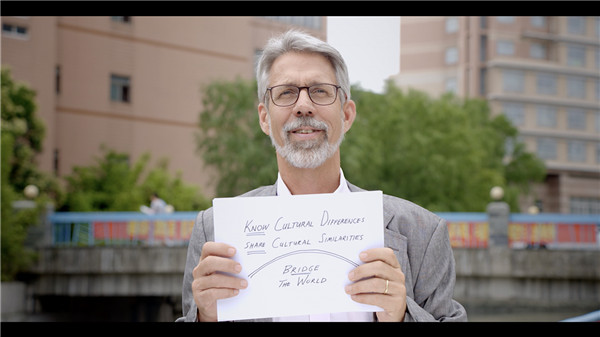
(Steve J. Kulich, Executive Director of the SISU Intercultural Institute)
Personal and academic home
In the summer of 1981, after teaching for two years in Taiwan’s Tunghai University, Steve first set foot on the Chinese mainland. His two-week-long journey ended with a three-day stay in Shanghai. The many factories, busy workers, clanging of bicycle bells, and busses full of people were his first impressions, but also signs of the new opening-up policy, with some colorful clothes appearing among the traditional blue and grey Mao suits, the first big billboard advertisements (surprisingly of “The Marlboro Man”), and a few shiny imported motorcycles and cars.
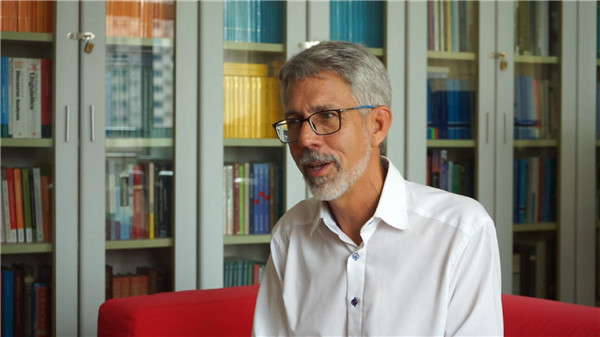
(Steve has an interview with Eastday.com)
Though China’s reform and opening up had started, in Steve’s eyes, Shanghai did not change very much in the 1980s. Developments took off after Deng Xiaoping’s Southern Tour, just before the Kulich family moved to SISU. High-rise buildings and overpasses quickly began springing up. Coal burning factories were moved out, construction of new housing or office areas became omnipresent and he saw a new Manhattan taking shape.“Everything was just picking up, and we had this sense that we could be part of this developing city and somehow contribute,” said Steve.
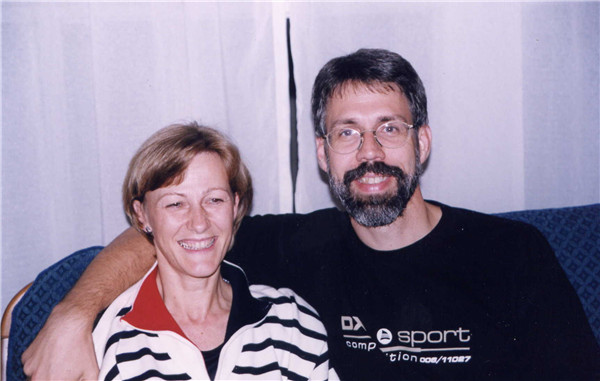
(Steve and his wife in the 1980s. Photo provided by Steve J. Kulich)
The international atmosphere here was another reason why he and his family chose Shanghai. Coming in 1993 with two young children, an environment with good hospitals, educational options, and some German-speaking families for language and cultural support were attractive. Many German companies had joint ventures in Shanghai, like Volkswagen, Siemens, Henkel, and with an active German consulate, there was hope of possible German school support as the children grew, which indeed happened. After attending Chinese kindergarten and 3 years of Chinese primary school, both girls graduated from the German School Shanghai and his wife served on the school board and as a consulting doctor for the consulate.
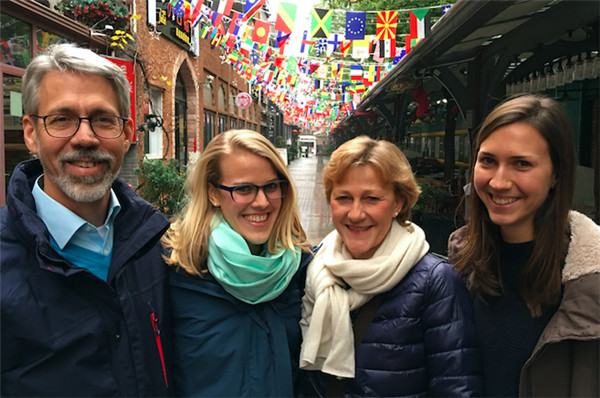
(Steve and his family. Photo provided by Steve J. Kulich)
With a master’s degree in intercultural communication, Steve started to teach at SISU’s Overseas Training Center in 1993, primarily providing training for scholars preparing to study abroad and employees upgrading their competencies for State-owned Enterprises and multinational enterprises. It was there that he started intercultural communication orientation courses in 1994 and also sought contact with Chinese scholars pioneering the intercultural communication field here.
When he had previously undertaken a survey of China’s understanding of intercultural communication for his master’s thesis, he could find only five books, none of which were particularly deep. However, the academic field, which grew out of comparative studies in anthropology, psychology, education and communication, had formalized in the US by 1970. By the time Steve finished his MA in 1992 IC was mature and also expanding in Japan, Germany, France and other countries. However, when it came to East-West cultural comparisons, many people reverted to Japanese and American comparisons. For various reasons, the world’s understanding of China, and China’s of the world, were lagging behind. But by the late 1980s, Chinese teachers were focusing more on language and culture teaching, and similar to Steve at SISU, intercultural communication courses were opened in Beijing Foreign Studies University (BFSU), Harbin Institute of Technology (HIT), Beijing University, Fujian Normal University, and other Chinese universities. It was a great time to come, contribute, and collaborate!

(Steve’s library room is full of intercultural research literature and textbooks.)
In 1995 Steve was thrilled to learn of the founding of the China Association for Intercultural Communication (CAFIC) in Harbin, and in 1997 he attended its second conference at BFSU. Since then, that association has been his domestic academic home. Its members are mostly teachers and scholars from various fields like FLT (Foreign Language Teaching), TCFL (Teaching Chinese as a Foreign Language), linguistics, translation studies, communication, and psychology, who gather to share their latest work on intercultural research and education. Seeing a need for stronger academic publications to develop the field, Steve initiated a thematic book series called Intercultural Research (published by SISU’s press, SFLEP) though he and his co-editors have recruited top scholars from China and abroad to publish on topics like identity, values, adaptation, and interculturality (the series has been recognized for several best book awards).
Thanks to the relationships built through the association’s annual conferences, in 2003 Shanghai became the first, and still sole, city recognized with an official branch. Compared with other Chinese cities, Steve thinks Shanghai has past and present advantages in terms of intercultural communication research. “There are quite a few universities in Shanghai interested and engaged in this area because of the need to communicate with the world, and Shanghai has a history of being an international city.” In addition to annual faculty meetings and an important conference series, the Shanghai CAFIC branch also organizes inter-school graduate thesis competitions to promote mutual interaction and collaboration between universities. “I’ve been very lucky to grow up with the discipline here,” said Steve.
Developing a discipline to develop people
Steve’s Chinese name is 顾力行 (Gu Lixing), which, according to him, summarizes his life purpose. “力 (Li) means that I try to depend on God’s strength to provide what I need every day to cultivate inner capacity. 行 (Xing) is to live out that capacity. 顾 (Gu) is to seek to be a good advisor or help to care for others.” His name is therefore a reflection of his dedication to China’s education.
At SISU, Steve not only founded intercultural communication (IC) courses, but several IC programs. In 2002, he was asked to start the intercultural communication MA program, and by recruiting a group of like-minded local and overseas colleagues, they have trained over 300 MA graduates in IC. During 2005, he, Prof. Zhang Hongling and several others at SISU drafted plans for a research center to integrate resources, promote the development of the discipline, and better serve the university and its students.
Thanks to university-level support, the SISU Intercultural Institute (SII) was launched in September 2006 and has steadily grown in staff members and influence. Currently, there are eight core academic scholars/staff on the team and other affiliated partners in other colleges. SISU has become one of the leading locations for teaching and researching IC as an interdisciplinary subject, especially through the IC “state of the field” and “disciplinary development” conferences that were hosted in 2006, 2010, 2014, and 2016, and publication of the institute’s books and key articles. Since 2010, SISU has been recruiting PhD students and more than a dozen of the first graduates are now working to build the field in universities across China.

(Inauguration ceremony for the SISU Intercultural Institute. Photo provided by Steve J. Kulich)
As Executive Director of SII, Steve has many responsibilities. Admittedly relying heavily on his team for administration, research collaboration, and the wide range of roles the SII is asked to perform, he feels that his greatest strengths are in understanding the history of the field, getting to know key scholars, building international cooperation, and sharing this with his students in the classroom.“I’m good at encouraging other people and motivating other people to do their research. In fact, the motto of our Institute is ‘developing a discipline to develop people.’ I really feel that intercultural teaching, training and doing research makes you more aware of how to compare, contrast and adapt, so people can grow as better people. We call it intercultural competence, international awareness, global citizenship and many different terms, so I feel pleased I’ve been able to invest in that.”
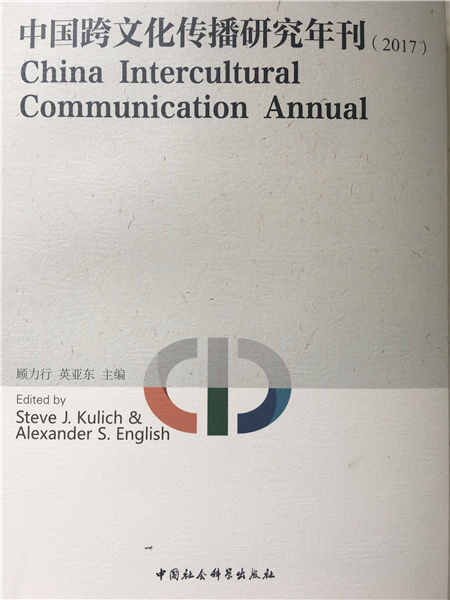
(Steve is the co-editor of China Intercultural Communication Annual (2017). Photo provided by Steve J. Kulich)

(Steve and SII’s fellow team in the early years of SII. Photo provided by Steve J. Kulich)
Steve’s teaching career at SISU also gives him plenty of research inspiration, which he is always grateful for. When he was teaching in SISU’s Overseas Training Centre from 1993-2002, he was exposed to different kinds of Chinese, allowing him to make systematic and localized research on Chinese values. “We’ve filled out a lot of small questionnaires and surveys. I’ve gathered a lot of data, and just talking with my students every day in class was a learning experience. Every day I learn something new.”
Being imbedded in the system and in relationships all these years, when he started presenting papers at international conferences, people were intrigued by new perspectives on China. Much international scholarship still focuses on linking Chinese ideas or behavior to Confucianism as a basis for face practices, guanxi, or collective stereotypes. But by linking his student’s feedback with international values survey and the cultural psychology of bi-lingual identities, Steve could use research to tell updated Chinese stories on people’s motivations, daily lives, social relationships, modernization and culture change trends in China today. As Steve said, “For my research on values change, identity development and social interaction, this job has been perfect for me.”
Last year, Steve was elected as incoming president of the IAIR (International Academy for Intercultural Research), an executive role for six years. In addition, SISU was approved as the host for the next biennial conference of the IAIR in 2019 (to be held jointly with CAFIC), coinciding with SISU’s 70th anniversary! While he grows into his presidential role, he and his team are busily preparing for this significant opportunity to showcase SISU, domestic IC scholars, and today’s China. “Our goal is to recruit many more top Chinese scholars into the Academy, either as academic fellows or members to learn from people from countries such as Germany, France, South Africa, Ghana, and Norway. We have so many countries that are doing intercultural research now, so we can connect to the world. That’s the idea of China’s vision of globalization, and of how we can really build this shared future for mankind.”
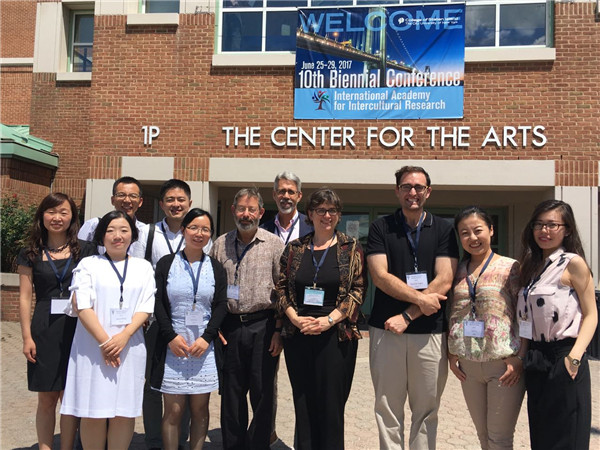
(Steve attended the 10th IAIR Biennial Conference in New York in 2017. Photo provided by Steve J. Kulich)
“Intercultural communications can truly contribute to that dialogue,” added Steve,“telling Chinese stories, but also helping the world understand China through first-hand experience.”
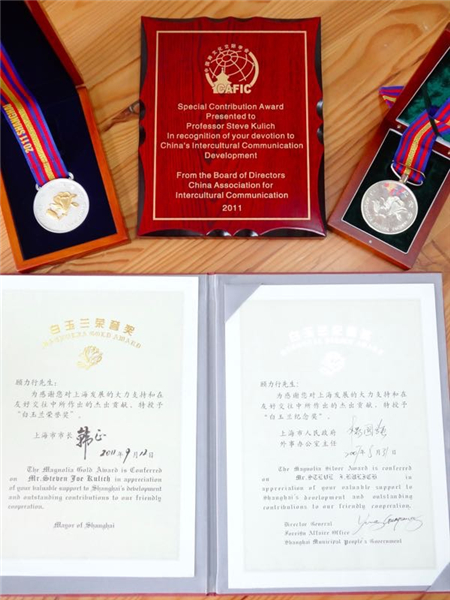
(Steve won Shanghai Magnolia Silver and Gold Awards in 2007 and 2011. He was also honored with a Special Contribution Award from CAFIC in 2011. Photo provided by Steve J. Kulich)
As a self-titled “human developer,” Steve pays more attention to people’s personal cultivation and encourages the personal and national benefits of people-to-people exchanges. China already has a leading position in many areas in the world, such as exports, imports, and the largest PPP (a competing measure to GDP that takes into account the relative cost of local goods, services and inflation rates) economy. Therefore,“We should use this ability to really build through the Belt and Road initiative, and be giving, be exchanging, and working together. I think that’s the spirit that needs to keep happening.”

(Steve’s wishes for China’s further reform and opening up)
【改革开放40周年40人】“美国夫子”顾力行:与中国跨文化交际学科一起成长
年少时的他,从烟花包装纸上第一次了解到中国;青年时,他与同样来自异国他乡的妻子定情厦门大学;年过而立,他选择扎根上海,面向国际,用跨文化交际的话语,让中国了解世界,向世界介绍中国。
他是来自美国的顾力行(Steve J. Kulich)教授,上外跨文化研究中心执行主任,从事跨文化价值观与身份认同研究。在校内一间简易的图书室,记者见到了顾力行教授。也就是在这里,他为全球的慕课(MOOC)学员在线讲授“跨文化交际”课程,解读中国文化身份、价值观与传播方式。

(上外跨文化研究中心执行主任顾力行)
身心归处,便是故乡
1981年夏,已经在台湾东海大学执教两年的顾力行首次踏上中国大陆的土地,为期两周的旅行以在上海停留的三日结束。遍布的工厂、忙碌的工人、满大街“叮铃铃”的自行车、挤满人的公交、街边的万宝路广告牌、时髦的进口摩托车、清一色的中山装中逐渐有些色彩鲜艳的服装……这是他对上海最初的记忆。

(顾力行接受东方网记者采访)
顾力行认为,上世纪80年代的上海在改革开放初期,变化并不大,上海发展真正步入快车道是在邓小平南方谈话之后。一座座高楼和高架桥拔地而起,烧煤厂逐渐搬离市区,房产开发方兴未艾……他看到了浦江之畔“一座曼哈顿的崛起”。也就是在那时,1993年,顾力行带着他的德国妻子和两个女儿定居上海,一待就是25年。他说:“当时上海发展开始起步,我感觉我们也是这个变革的一分子,并可以为此做些什么。”

(顾力行和妻子早期合照。本图由受访者提供)
上海的国际化环境也是顾力行选择上海的原因之一。当时上海已经有不少中德合资、合作企业(如大众、西门子、汉高等),大量德国家庭居住于此,这对顾力行的德国妻子和两个女儿来说,是最好不过的生活环境。

(顾力行一家。本图由受访者提供)
1993年开始,拥有跨文化交际硕士学位的顾力行在上外出国留学培训部(OTC)任教,为准备出国留学的学者和从事跨国商务的企业员工提供培训。与此同时,他来中国工作还有一个愿望,就是在中国和世界跨文化研究学者之间搭建起一架连接彼此的桥梁。
这是因为几年前,他在写论文时发现中国关于跨文化交际的文献很少,也不够深入,他能找到的参考书仅5本。而早在1970年的美国,跨文化交际学就在人类学、心理学、教育学和传播学比较研究的基础上诞生,成为一门研究领域。到90年代,发展已经相当成熟。日本、德国、法国等国家的跨文化交际学也发展迅猛。遗憾的是,在东西方文化比较方面,很多文献都是拿日本和美国进行对比分析。中国与世界对彼此认知的匮乏可见一斑。
让顾力行感到欣慰的是,从80年代后期,北外、上外、哈工大、北大、福建师范大学等高校先后开设了跨文化交际课程。1995年,中国第一届跨文化交际学术会议在哈工大召开并成立了中国跨文化交际学会。1997年,顾力行前往北外参加第二届研讨会,从此中国跨文化交际学会便成为他的“学术家园”。这里有来自外语界、对外汉语界、传播学界、语言学界、翻译学界和心理学界的学者、教授、科研人员,从不同研究角度分享有关跨文化研究的理论探索与实践创新成果。顾力行提议编撰《跨文化研究》(Intercultural Research)论丛,邀请中外学者发表跨文化话题的学术研究论文。

(顾力行在上外的图书室里,堆满了跨文化研究的文献和教材)
学会建立的校际联系网络,也方便了各高校跨文化学者之间的交流。2003年,中国跨文化交际学会上海分会正式成立。在顾力行看来,相较于其他城市,上海在跨文化交际方面有独特的优势:“上海高校云集,与国际交流频繁,而且上海历来就是个国际化的都市。”除了每年的例行会议,上海分会还积极举办校际论文竞赛,促进相互间的交流互动,为协作搭建平台。
我国的跨文化交际研究起步较晚,在研究领域和研究方法等方面与美国等国家有一定差距,但在这20多年的发展中也取得了一定成绩:跨文化教育和研究得到更多关注和认可,从浅层教育走向深层发展,从英语教学中的跨文化交际能力培养、拓展到国际汉语教学中的跨文化交际能力培养。有越来越多重点大学(上外、北外、北大、武汉大学等)设立了跨文化研究的硕士点和博士点。进入21世纪,我国出版社相继引进国外传播学和跨文化交际学的权威经典著作,对跨文化交际学在我国的传播和发展起到了积极的推动作用。
顾力行满脸幸福地说:“我很幸运,能与中国的跨文化交际学科一起成长。”
发展学科,旨在育人
谈到自己的中文名,顾力行告诉记者,这个名字代表了他的人生目标:“顾,有顾问、照顾的含义;力行,意思是践行上帝赐予我内心的力量。”这也是他在教育岗位上兢兢业业的写照。
在上外,顾力行首开跨文化交际学课程,2002年又创立跨文化交际研究方向,与一群志同道合的同事见证了跨文化学科在上外的成长。十余年间,已培养了300名跨文化方向研究生,他们都是深谙中外沟通之道的有识之士。2005年初,他和上外张红玲教授等人在共同发展跨文化教学研究时产生了一个共识,即建立一个能整合相关资源,加强该学科建设并更好地服务学校和学生的研究中心。在校方的支持下,上外跨文化研究中心(SII)于2006年9月成立。目前,中心团队已有8名核心教学成员。跨文化交际是一门融合性学科,中心也吸引了其他学科领域的人才和学术力量,与英语学院、传播学院、国际工商管理学院以及上外MBA-无国界全球管理者项目建立了合作关系。

(上外跨文化研究中心揭牌仪式。本图由受访者提供)
担任中心执行主任的顾力行,深感责任重大。钟爱教学的他坦言,自己更擅长鼓励他人做科研:“发展学科,旨在育人。这是我们跨文化研究中心的宗旨。从事跨文化教学、培训和研究,可以让人认识到不同文化间存在的差异,通过对比、冲突再到适应的过程,得以获得成长。这就是我们所说的跨文化能力、国际意识、世界公民。所以我想,在这方面,我能为中心竭尽自己所能。”

(顾力行参与主编的《中国跨文化传播研究年刊》(2017)。本图由受访者提供)

(上外跨文化研究中心成立早期,顾力行与研究团队成员合照。本图由受访者提供)
同时,顾力行也很感激,上外的教学生涯为他提供了丰富的研究素材。1993至2002年,他在出国留学培训部的教学工作让他有机会接触到形形色色的中国人,对中国人的价值观有系统化和本土化的研究。“我做了很多问卷调查,收集到大量的调查数据。每天在课堂上和学员交流,都让我有新的收获。”
“近水楼台先得月”,与中国这份独特的联系,也让顾力行在参加各种国际性会议时,能够提出众多关于中国的新思想、新见解,向世界展示一个崭新的中国。当时许多国际学者对中国的研究大多还是基于旧时的教科书,或者仅限于儒家思想、刻板印象,他们对现代化的中国、中国人的日常生活和人际关系知之甚少。“因此,这份工作为我从事价值观、身份认同、社会交际等方面的研究,提供了最佳的平台。”
2017年,顾力行当选国际跨文化研究学会(IAIR)新一届会长,任期六年。他笑着说,自己现在还在学习如何做一名合格的会长。令他同样激动的是,明年恰逢上外建校70周年,也是中国建国70周年,IAIR双年会将在上外举办,向世界介绍今日中国。“我们将邀请更多中国高端学者和研究员,与来自德国、法国、南非、加纳、挪威等国家的成员互学互鉴,如今有很多国家都在开展跨文化研究,借此机会,我们可以连接起整个世界。这也和中国的全球化愿景、构建人类命运共同体的理念十分契合。”

(顾力行在美国纽约参加2017年IAIR会议。本图由受访者提供)
这位美国教授说,跨文化交际可以真正实现各国间的对话:“不仅向世界讲述中国故事,也让世界通过第一手经验了解中国。”

(顾力行于2007年和2011年分别获得上海市白玉兰纪念奖和荣誉奖;2011年,被中国跨文化交际研究学会授予“特殊贡献奖”。本图由受访者提供)
身为一名人文学者,顾力行更关注人类内心的建设,也更相信人心相通的力量。他表示,如今中国在世界舞台上的地位日益凸显,在进出口、PPP(购买力平价)等诸多方面已经领先世界,“中国应该发挥这些优势,通过‘一带一路’,真正实现给予、交流、合作,并将这种精神延续下去”。

(顾力行寄语中国改革开放再出发:感谢改革开放40年让我们来到了中国,我衷心希望,未来的政策、实践、目标和期望不仅可以推动人们在全球各地进行投资、做出贡献并产生积极影响,同时也可以加深我们对自身文化以及对彼此的欣赏、理解和包容,增强合作,以促进相互交流、共同成长,加强人际关系,获得心灵上的满足——真正构建人与人、群体与群体、国家与国家之间的命运共同体。)